CRM built around your processes
We design and ship CRM that fits your operations, integrates with your stack, and scales. MVP in 12-16 weeks. Enterprise-grade data model, role-based access, audit, and API-first integrations.
CRM development approaches
| Parameter | Custom | SaaS | Hybrid |
|---|---|---|---|
Platform |
Not required |
Required |
Required |
Developers |
Required |
Not required (or minimal) |
Required |
What it is |
Built from scratch: architecture, UI, logic, integrations. Full code and data ownership. |
Subscription to a ready CRM (Salesforce, HubSpot, Dynamics, Zoho). Configure fields, automations, and integrations. |
Platform as the core; your custom modules, microservices, integrations, and UI around it (e.g., Salesforce, Dynamics, Creatio, Odoo). |
Pros |
|
|
|
Cons |
|
|
|
Parameter
Platform
Developers
What it is
Pros
Cons
Custom
Not required
Required
Built from scratch: architecture, UI, logic, integrations. Full code and data ownership.
- Exact fit to your processes;
- control over architecture, security, scale;
- no licenses/subscriptions.
- High upfront cost and longer delivery;
- maintenance and evolution on your side;
- risk of tech debt without a strong team.
SaaS
Required
Not required (or minimal)
Subscription to a ready CRM (Salesforce, HubSpot, Dynamics, Zoho). Configure fields, automations, and integrations.
- Fast start (weeks, not months);
- no dev team needed;
- vendor handles updates, support, security.
- Limited flexibility;
- license costs grow with users;
- not everything adapts to your process;
- risk of “plugin Frankensteins” for complex scenarios.
Hybrid
Required
Required
Platform as the core; your custom modules, microservices, integrations, and UI around it (e.g., Salesforce, Dynamics, Creatio, Odoo).
- Balanced approach: quick platform baseline + freedom for unique logic;
- lower risk than full custom;
- evolve without rewriting the core.
- More moving parts to manage (platform + custom);
- integration and versioning complexity;
- needs governance and engineering discipline.
We advise building a custom CRM when
- The off-the-shelf solutions can’t model your core process without hacks or a plugin “Frankenstein.”
- Data control/compliance first: on-prem, KMS, segregated zones, strict audit.
- Scale/performance is a mandatory and highly acute requirement, including event-driven design, CQRS, stream processing, and low-latency paths.
- Per-user licensing kills margin while you still rewrite core logic.

| What a custom CRM looks like | What it requires |
|---|---|
MVP (core CRM + key integrations) |
~12–16 weeks of development; |
Enterprise release (RBAC, audit, SLAs, HA, analytics, mobile) |
9–18 months of development; |
TCO |
Higher upfront; |
What a custom CRM looks like
MVP (core CRM + key integrations)
Enterprise release (RBAC, audit, SLAs, HA, analytics, mobile)
TCO
What it requires
~12–16 weeks of development;
6–10 specialists (PM/BA, UX, 3–5 devs, QA, DevOps)
9–18 months of development;
10–25 specialists involved;
staged rollout.
Higher upfront;
can be lower than platform licenses over 3–5 years for 500+ users and heavy integrations, especially if you invest in disciplined support.
Custom CRM software development services
End-to-end development
CRM modernization
Data migration
Integration services
Automation & AI
CRM UI/UX design
CRM support & maintenance
End-to-end development
CRM modernization
Data migration
Integration services
Automation & AI
CRM UI/UX design
CRM support & maintenance
Interested in developing your custom CRM?
Get a free consultation from our team.
We advise building a hybrid CRM when
Hybrid CRM is the case when we use platform capabilities as core functionality while building custom modules around it. With hybrid CRM, we add custom microservices, integrations, and UI for the parts that make your business unique.
- Core fits platform; edge cases don’t. 80% of flow maps to the platform, 20% is your competitive edge.
- You need integrations first. ERP, billing, DWH/MDM, telephony, marketing tools via APIs/event bus.
- Security split required. Part of data/process stays on-prem or in a segregated zone.
- Licensing is fine, but extensibility is key.
- You accept per-user licensing and want official extensibility, not hacks.

| What hybrid gives | Why it matters |
|---|---|
Fast core rollout |
Platforms cover 70–80% of typical CRM needs out of the box. You go live in weeks, not months. |
Freedom for unique logic |
Build the tricky 20–30% yourself: lead routing, pricing/bonus engines, approvals, domain-specific processes. |
Long-term stability |
The platform keeps updating; your custom parts stay independent. No “version lock-in.” |
Risk reduction |
If custom code needs a rework, core CRM still runs. You don’t bet the farm on greenfield. |
Data & security control |
Keep sensitive data or specific logic in your perimeter; push the rest to the platform. |
Stepwise scale |
Start with baseline CRM, add analytics, scoring, AI automation later – without rewrites. |
What hybrid gives
Fast core rollout
Freedom for unique logic
Long-term stability
Risk reduction
Data & security control
Stepwise scale
Why it matters
Platforms cover 70–80% of typical CRM needs out of the box. You go live in weeks, not months.
Build the tricky 20–30% yourself: lead routing, pricing/bonus engines, approvals, domain-specific processes.
The platform keeps updating; your custom parts stay independent. No “version lock-in.”
If custom code needs a rework, core CRM still runs. You don’t bet the farm on greenfield.
Keep sensitive data or specific logic in your perimeter; push the rest to the platform.
Start with baseline CRM, add analytics, scoring, AI automation later – without rewrites.
How major CRM platforms handle custom functionality
All leading CRM platforms officially support adding custom functionality around the core product. They expose SDKs, plugin models, UI extension points, APIs, sandboxes, and marketplaces so you can build custom logic, screens, and integrations without hacks and stay upgrade-safe. We use them in our custom crm software development services.
Salesforce
Developers can build custom UIs with Lightning Web Components and wire server logic in Apex. The platform lets teams package and version features as managed packages and publish them on AppExchange. It’s possible to model new data objects (custom objects), set granular RBAC, and expose APIs for external systems.
Microsoft Dynamics 365 / Power Platform
The native functionality expansion works through .NET plugins, custom tables/forms/apps. There are multiple official guides on plugins and development tools.
HubSpot
The platform provides multiple extension opportunities: UI, CRM cards, events, and more. There is an SDK for embedding custom entities directly into the CRM records. The functionality is constantly evolving along with the developer platform.
Zoho CRM
The platform supports custom JS widgets through JS SDK, custom functions,and connections with external APIs. It’s also possible to embed the full web apps directly into CRM screens.
SAP Sales/Service Cloud (C4C)
The platform provides an official SAP Cloud Applications Studio (PDI, SDK), that supports UI changes, new fields, custom logics, mashups, and much more.
Oracle CX Sales
Oracle also has a vast ecosystem of official tools for customizing the core CRM functionality. Tools like Application/Page composer, Groovy scripts, web services enable changes in UI, logic, services, and data flows. There are numerous guides on how to expand the native functionality.
4 types of CRM systems to use
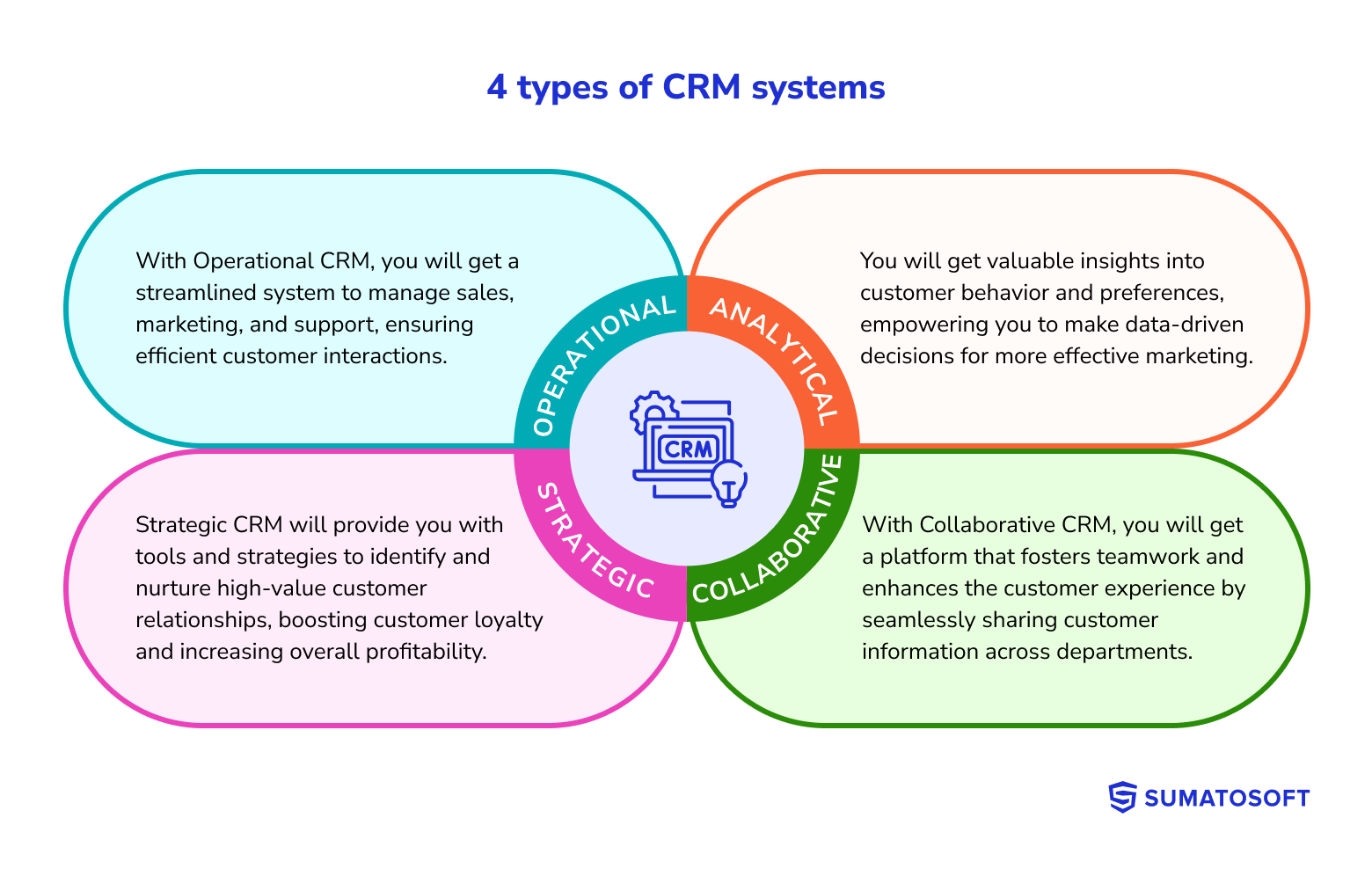

Industry-specific CRM solutions
Industries may have nuances and require a CRM that is specifically tailored to that industry. For them, we work with industry-specific ready-made CRMs or provide custom crm software development services when we build the system from scratch. Below are the industries that see benefit from such industry-specific solutions.
Healthcare & Homecare
Authorizations, referrals, visit scheduling, care-plan updates, and case notes must flow without retyping. We model PHI correctly, enforce role-based access and audit, and integrate with EHR/EMR (HL7/FHIR), payer portals, billing, and telephony. Result: fewer handoffs, cleaner documentation, faster approvals—without violating HIPAA/GDPR.

Manufacturing & Logistics
Sales needs CPQ and dealer portals; ops needs order orchestration and RMA; planners need ATP and OTIF. We connect CRM to ERP/MRP, WMS/TMS, and EDI/ASN so quotes, orders, shipments, and returns live on one timeline. Telematics/IoT events can update orders and cases in real time for accurate ETAs and exceptions management.

FinTech & Banking
Onboarding, KYC/AML, sanctions screening, and product cross-sell demand precise controls. We implement maker–checker, SoD, audit trails, and data-residency policies; integrate with core banking, PSPs, risk/fraud engines, ledgers, and identity providers. Cases, alerts, and investigations stay traceable end-to-end.

Retail & E-commerce
A single customer view drives loyalty, promos, service, and returns. We stitch POS/OMS with the web store, CDP, and marketing automation, then surface purchase history, tickets, and interactions in one place. Rules for pricing/discounts, inventory signals, and omnichannel behavior support targeted offers and faster resolution.

Real Estate & Construction
Pipelines are project-centric, encompassing RFIs/RFQs, bids, change orders, site visits, and document control. We wire DocuSign and accounting, link to BIM/CAD or permit systems, and enforce approvals per role and project. The result is fewer blockers between lead, contract, and handover.

SaaS & B2B Services
Growth depends on usage and renewal, not just new deals. We map PLG funnels (trial → paid), onboard customers, run success playbooks, and track health scores. Product analytics and in-app events feed CRM; billing, support, and email/SMS stay in sync. Renewals, expansions, and churn-risk alerts become predictable work, not guesswork.

Addressing common challenges
We understand that custom or hybrid CRM development raises concerns. We also know how to address these concerns so that you have nothing to worry about.
ROI & total cost of ownership
You need proof that your CRM will pay for itself without creeping scope and vendor bloat.
How we address it: We build a clear value hypothesis up front (cost-to-serve, conversion, retention, cycle time), tie it to measurable KPIs, and phase delivery so each tranche unlocks a specific business benefit. Our cost model covers build + run (licenses, cloud, support, data operations) so you see CapEx/OpEx before you commit.
Vendor lock-in
Enterprises fear being trapped by a single platform or bespoke codebase.
How we address it: We favor a hybrid stack: proven CRM platforms for core objects and workflows, plus a modular services layer for custom logic. We keep integrations API-first, document interfaces, and use exportable data schemas so you can move or extend later without rewrites.
Integration with existing systems
CRMs fail when they don’t speak ERP, CPQ, billing, contact centers, or data lakes.
How we address it: We design integrations as products: versioned APIs, event streams where real-time matters, batch where it doesn’t, and idempotent jobs for reliability. We can use iPaaS if you prefer, or code where performance and control are critical.
Security & compliance
Customer data demands enterprise-grade security and regional compliance (GDPR and beyond).
How we address it: Zero-trust by default, encryption in transit/at rest, least-privilege RBAC/ABAC, audit trails, and segregation of duties. We align processes to ISO-style controls and bake privacy by design into data models and retention policies.
Scalability & performance under load
Spikes from campaigns or call-center peaks shouldn’t slow your teams.
How we address it: We set performance budgets, load-test critical flows, and size infrastructure with auto-scaling. Caching, asynchronous processing, and observability (tracing, metrics, logs) are part of the first release, not a later “hardening” phase.
Timeline risk & delivery predictability
Large CRM programs can drift.
How we address it: Dual-track discovery to de-risk unknowns, then short delivery cycles with demoable outcomes every 2–3 weeks. We publish roadmap, dependencies, and risks openly and manage them by KPIs (lead time, change failure rate, cycle time).
Need CRM that fit your business processes?
Get in touch and discuss your business needs with our pro team.
Professional community values our approach
Leaders notice when a vendor blends rigor with results. Our work is referenced by clients and industry analysts alike because we deliver measurable outcomes.
Proven with global brands
For a global automotive network (Toyota dealerships), we engineered a custom CRM module that integrated with existing systems and automated sales and service workflows. The CRM system resulted in lower operating costs, faster sales cycles, and higher customer retention rates, thanks to responsive support and personalized service reminders.
Outcomes that move the needle
Well-implemented CRMs consistently lift revenue. Independent reports cite up to ~29% average sales growth from effective CRM use; with tight process alignment, organizations see dramatically higher conversion and win rates. Our hybrid approach, with the usage of a standard platform and developing custom modules, exists to capture those gains in your context.
A team the market trusts
Since 2012, we’ve delivered over 250 solutions, achieving a 98% Client satisfaction rate and a 70% return rate of clients. You work with 60+ specialists, 70% at senior level, across modern CRM stacks (Java, .NET, Ruby on Rails, Python, cloud, AI). Architecture is designed for scale, security, and change from day one.
Delivery you can plan around
We commit to a shared delivery schedule, biweekly demos, and named contact points, so you always know where the project stands. Timelines and budgets are realistic – and visible. You also receive read-only access to our project management system, ensuring complete transparency and confidence from day one.
Quality and security built in
Every feature ships against explicit acceptance criteria and goes through rigorous QA. We implement enterprise-grade security (encryption, least-privilege access, auditability) and align to regional regulations such as GDPR and HIPAA when required.
How this benefits you
You get a CRM that your teams adopt, your stakeholders trust, and your leadership can defend: observable ROI, transparent governance, and a roadmap that won’t box you in as the business evolves.
Core tech stack we work with
Our Clients’ success stories
Quality assurance services for complex CRM
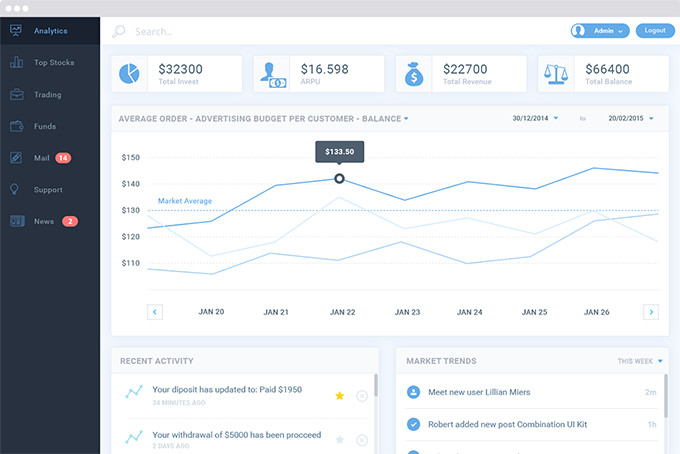

Custom ERP system for Toyota car dealer
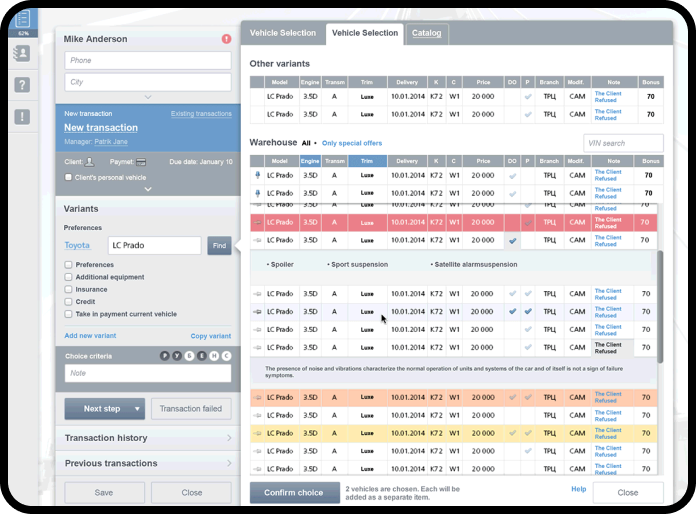

Real estate platform maintenance and enhancement for 5 years
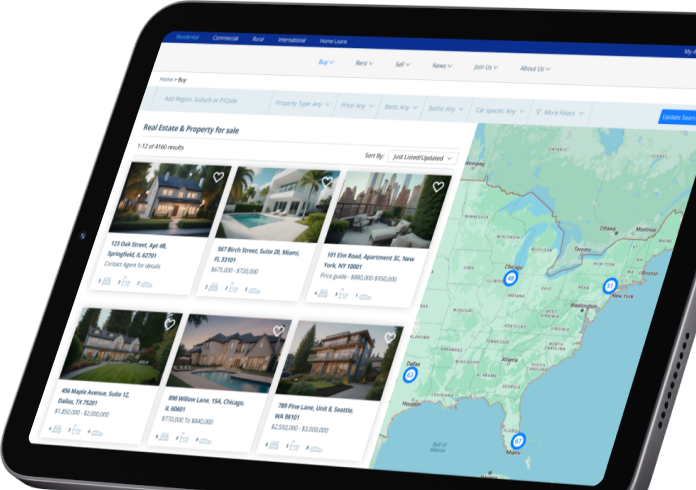

Quick facts about SumatoSoft
Your project starts here.
We’re ready to sign NDA
RFP analysis is absolutely free
We will respond to you within 24 hours

We have awesome stories to tell you
FAQ
Is it hard to create a Custom CRM?
Creating a CRM can be challenging due to the complexity of features, data management, and user interface design. It requires skilled development resources and thorough planning.
Should we build our own CRM?
Building your own CRM depends on your specific needs, resources, and expertise. Consider the complexity, time, cost, and customization requirements before deciding.
What do you need to build a Custom CRM system?
To build a Custom CRM system, you’ll need a team of developers, designers, and database administrators, access to infrastructure and servers, a detailed project plan, and ongoing resources for maintenance and updates.
Can SumatoSoft integrate Custom CRM solutions with my existing systems?
Absolutely! We specialize in seamless integration of Custom CRM solutions with your existing systems, ensuring a smooth transition and improved data accessibility.
What kind of support can I expect from SumatoSoft during and after the Custom CRM development process?
You can expect comprehensive support from SumatoSoft throughout the entire Custom CRM development journey. We provide guidance, training, and ongoing assistance to ensure the success of Your CRM system.


